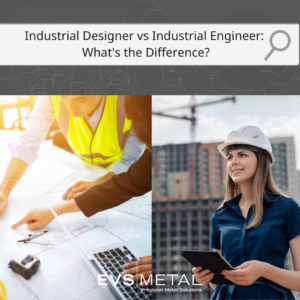Article Revised July 24th, 2022

EVS Metal was recently part of a job fair at a local technical high school. It was interesting to meet with students and find out about their career goals, and it also brought to light something we thought we should spend a little time clearing up in a blog, and that’s the confusion between the areas of industrial design and industrial engineering. They sound similar — we employ both IDs and IEs at EVS, and there is a degree of overlap, but they are not at all the same position and require very different educational backgrounds that are not interchangeable.
Industrial Designers: Roles & Responsibilities
First off, industrial designers are concerned more with form than function — art versus science. This isn’t to say they necessarily think form is more important, but their job focus is on improving aesthetics and usability, rather than the mechanics of the underlying functionality that make the object or part work correctly and satisfy certain quality or customer requirements.
Industrial Engineers: Roles & Responsibilities
Industrial engineers, on the other hand, are concerned primarily with function over form. Their most important job is to ensure that the ideas and concepts are translated into sound underlying mechanics that ensure that the part or product does its job as precisely and economically as possible. Although in some organizations a certain amount of tension may exist between the positions, a good ID/IE team will still be able to work together to design and engineer products that are both attractive and usable.
Looking for precision sheet metal fabrication and machining services?

Similarities Between Industrial Designers and Industrial Engineers
Both industrial engineering and industrial design professionals may interface with customers, so depending on their specific position, besides having the job skills required to carry out projects to completion, they often need to have strong sales and interpersonal skills to be able to communicate effectively both inside and outside of their organization. For instance, a customer may arrive to discuss their project with a team of several staff members, including a salesperson, a project manager, an IE, and an ID. Once the customer has explained their needs and accepted the team’s bid, the IE would draft technical drawings based on the required specifications, while the ID would ensure that from the standpoint of design the form of the object was optimized for the environment in which it was to be used.
At EVS Metal, we have more IEs than IDs, because so many of our customers come to us for specific parts, rather than complete products. That means the functionality of a part is generally more important than the aesthetics, because most of the time the part is hidden within a larger finished product. However, when we are asked to complete a full product prototype, IDs are an equally important part of the process, because customers want their end users to enjoy the finished product not just from a usability perspective, but from a standpoint of attractive design as well.
EVS is incredibly proud to employ an outstanding staff of skilled industrial engineers and designers, and they play a huge part in our end-to-end manufacturing capabilities. Discover how our IEs and IDs can add value to your manufacturing supply chain by simply requesting a quote online, or giving us a call at (973) 839-4432 today.
Those interested in industrial engineering and design careers with EVS can check the available positions on our job opportunities page. If no position is currently listed, we welcome potential employees to still submit their resumés as positions open up frequently due to our rapid growth.





